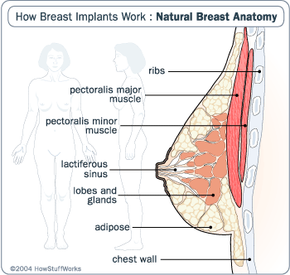Anatomy of a Breast
In order to understand how breast implants work, it helps to understand the structure of the breast. Breasts are tear-shaped, milk-producing glands that cover a woman's pectoral muscles and are suspended over the rib cage. They are held in place by supporting ligaments and muscles.
The structure of the breast is divided into two functional components: the epithelial component (the system that produces milk) and the structural component (the system of fatty tissue and ligaments that support and protect the structure of the breast).
Advertisement
The epithelial component is comprised of a series of 15 to 25 lobes arranged in an orderly fashion around the center of the breast (imagine the petals of a flower). Each lobe contains clusters of lobules that resemble clusters of grapes. All of the lobules end in dozens of tiny milk producing bulbs. The lobes all connect to a network of ducts called the lactiferous sinus, which carries milk to the nipple. The nipple is surrounded by the areola -- the dark, circular tissue that crowns the outside of the breast. The lactiferous sinus carries the milk through the nipple and out of the breast.
The structural component of the breast is comprised mostly of a fatty tissue called adipose. There is no muscle in the actual breast, but there are a series of muscles behind and underneath the breasts. These muscles work in conjunction with a ligament called Cooper's ligament, and together they act like a natural bra, supporting the weight of the breasts on the front of a woman's body.
The size and shape of a woman's breasts are primarily determined by hereditary. Other factors that can affect breast size (outside of traumas and cancer) include fluctuating weight, medications, pregnancy, menstruation, and menopause.
Click the play button to see inside of a breast.
If the above animation is not working, click here to download the Quicktime player.
In the next sections, we will examine how plastic surgeons use specialized tools and techniques to increase the size of breasts.
